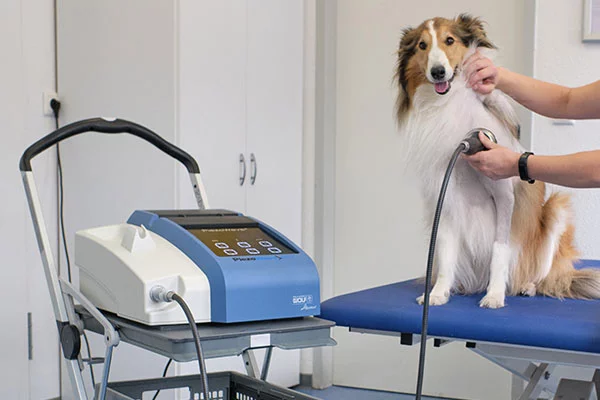Treating Arthritis Naturally: Shockwave Therapy
Arthritis affects 1 in 5 adult dogs and a growing number of cats, especially as they age. If your pet is slowing down, struggling to climb stairs, or showing signs of pain after exercise, osteoarthritis could be the cause.
Common signs of arthritis in pets include:
- Limping or favoring one limb
- Difficulty standing up or lying down
- Reluctance to climb stairs or jump into the car
- Decreased interest in play or exercise
- Muscle atrophy or weight gain
- Behavioral changes (irritability, restlessness)

Shockwave therapy can heal arthritis in your pet
NSAIDS (such as carprofen, deramaxx, and galliprant) or steroids (like prednisone or prednisolone) are typically utilized in pets. These can have a horrible impact on the liver and kidneys of any pet. Additionally, they do NOT reverse joint degeneration. Studies suggest that shockwave therapy offers more than just temporary relief—it can slow progression of arthritis and stimulate actual healing.
It’s heartbreaking to watch our once-active companions struggle to move, play, or get comfortable. That’s why it’s so important to explore options beyond just medications—especially those that support natural healing and long-term comfort.
What Is Shockwave Therapy?
Shockwave therapy, also known as extracorporeal shockwave therapy (ESWT), uses high-energy sound waves to stimulate the body’s natural healing processes.
In veterinary medicine, shockwave therapy is used to treat:
- Canine osteoarthritis (1)
- Hip and elbow dysplasia
- Non-union fractures or delayed healing bones
- Chronic PAIN – such as back pain
- Post-surgical healing – especially after a knee or hip surgery
- Tendon and ligament injuries – like cranial cruciate ligament tears (CCL tears)
This makes it one of the most promising natural arthritis treatments for dogs and cats—especially when combined with physical rehabilitation and lifestyle adjustments!
How Does Shockwave Therapy Help Arthritis?
Shockwave therapy addresses arthritis at the source by:
- Reducing inflammation Shockwave decreases inflammatory markers such as COX-2 and substance P, helping to reduce swelling and pain (3)
- Stimulating collagen production and tissue regeneration (4)
- Increasing blood flow to joints and surrounding tissues This includes the growth of new blood vessels—which is critical for delivering nutrients to damaged joints (3)
- Modulating pain through nerve desensitization By desensitizing nerves and decreasing local pain receptors, ESWT offers lasting relief without pharmaceuticals (2).
In summary, this holistic therapy doesn’t just mask symptoms—it promotes actual healing.
The Natural Choice for Pain Relief
One of the greatest advantages of shockwave therapy for pets is that it is:
- Non-invasive
- Drug-free
- Performed without anesthesia!
- Well-tolerated—even relaxing for many pets (including both cats AND dogs!)
For pet parents seeking a natural arthritis treatment without relying on long-term medications, shockwave offers real hope.
It’s also safe to combine shockwave with other integrative therapies, including acupuncture, laser therapy, hydrotherapy, and nutritional support—making it a powerful tool in holistic veterinary care.
What to Expect: A Typical Treatment Plan
- Treatments take 10–30 minutes.
- Usually 4–8 sessions, spaced at least 72 hours apart.
- Improvements are often noticeable within the first few treatments and continue for several months as tissue remodeling progresses.
The pet lies comfortably on a mat or padded surface while the practitioner applies the handheld probe to the affected area.
Some pets even fall asleep during treatment—it’s that gentle. Watch little Emi in the video during her shockwave treatments above!
Conclusion
Arthritis doesn’t have to mean a life of pain or pills for your pet. Shockwave therapy offers a safe, effective, and natural alternative that targets the root cause of joint degeneration and encourages healing from within.
At Healing Paws Center in Fort Lauderdale, we’ve seen incredible transformations. From senior dogs who couldn’t climb stairs, to athletic dogs with chronic elbow pain, to cats with hip dysplasia—we’ve witnessed pets regain their joy, movement, and vitality thanks to shockwave therapy.
If your pet is showing signs of arthritis, contact us today to schedule a consultation and learn how shockwave therapy can give your furry friend a new lease on life—naturally.
References:
- Haussler, K. K., et al. “Short-term clinical effects of extracorporeal shock wave therapy in dogs with hip osteoarthritis.” The Canadian Veterinary Journal11 (2012): 1187–1191.
- Kieves, N. R., et al. “Extracorporeal shockwave therapy in veterinary medicine.” Veterinary Clinics: Small Animal Practice5 (2017): 1161–1175.
- Wang, C. J., et al. “Biological mechanism of musculoskeletal shockwaves.” Journal of Orthopaedic Research6 (2003): 983–989.
- Dahlberg, J., et al. “Extracorporeal shockwave therapy increases subchondral bone porosity in osteoarthritic joints.” Veterinary Surgery4 (2005): 359–364.
- Lopes, M. A. F., et al. “Clinical use of shockwave therapy in dogs with hip osteoarthritis.” Veterinary Record17 (2014): 438






Leave A Comment
You must be logged in to post a comment.